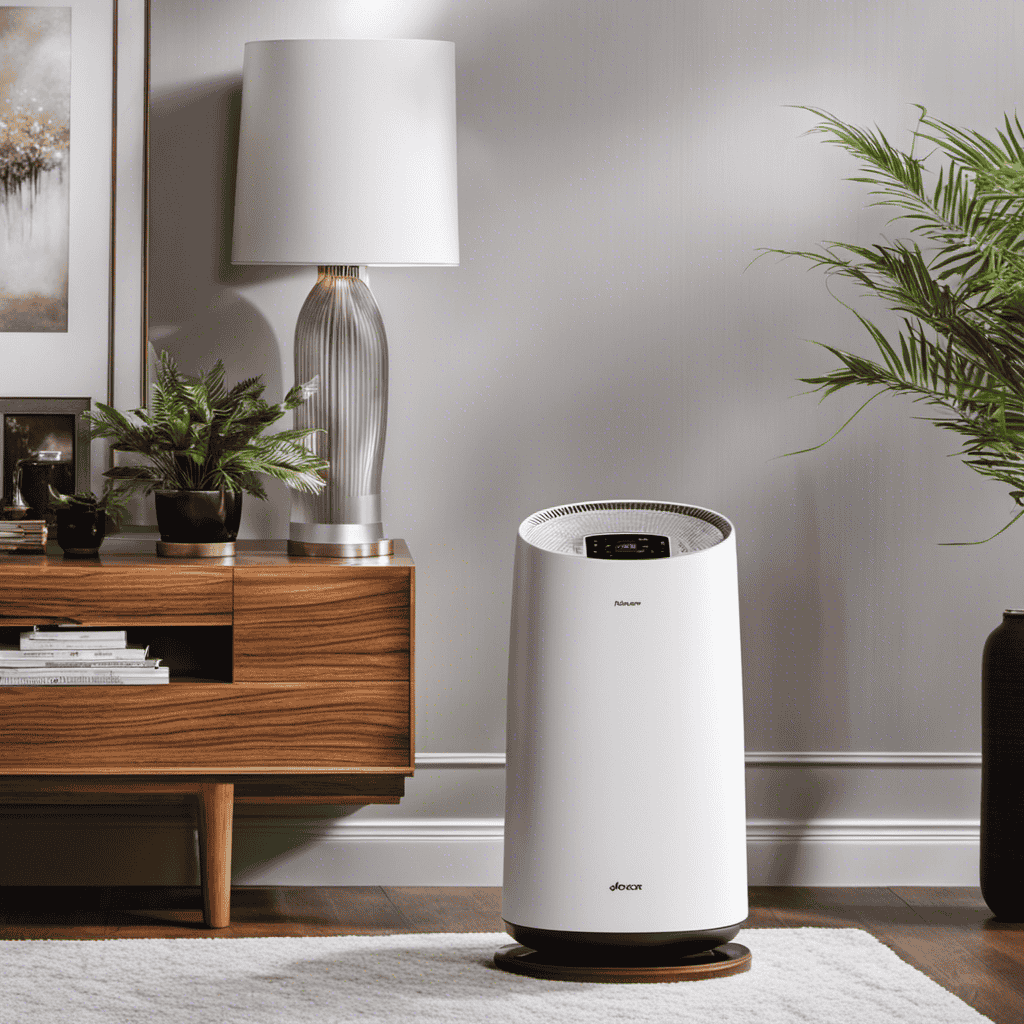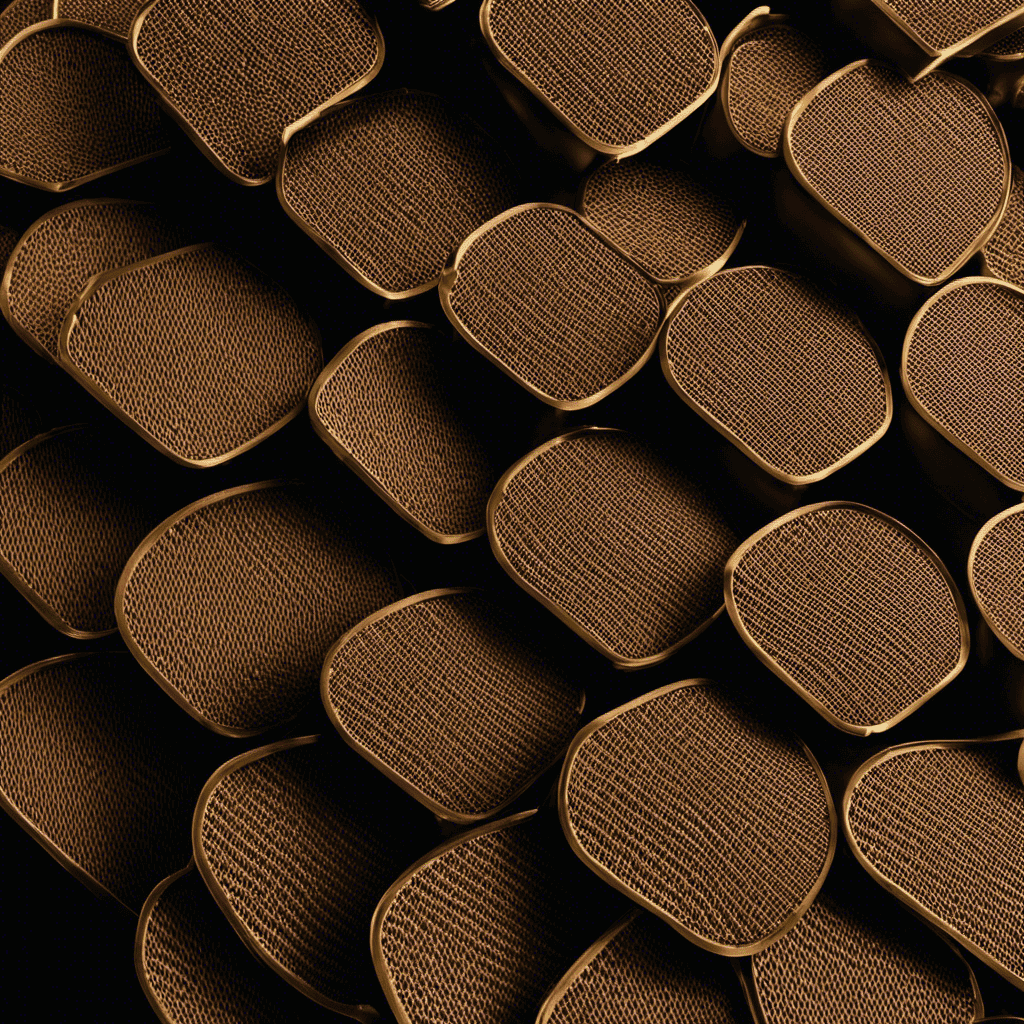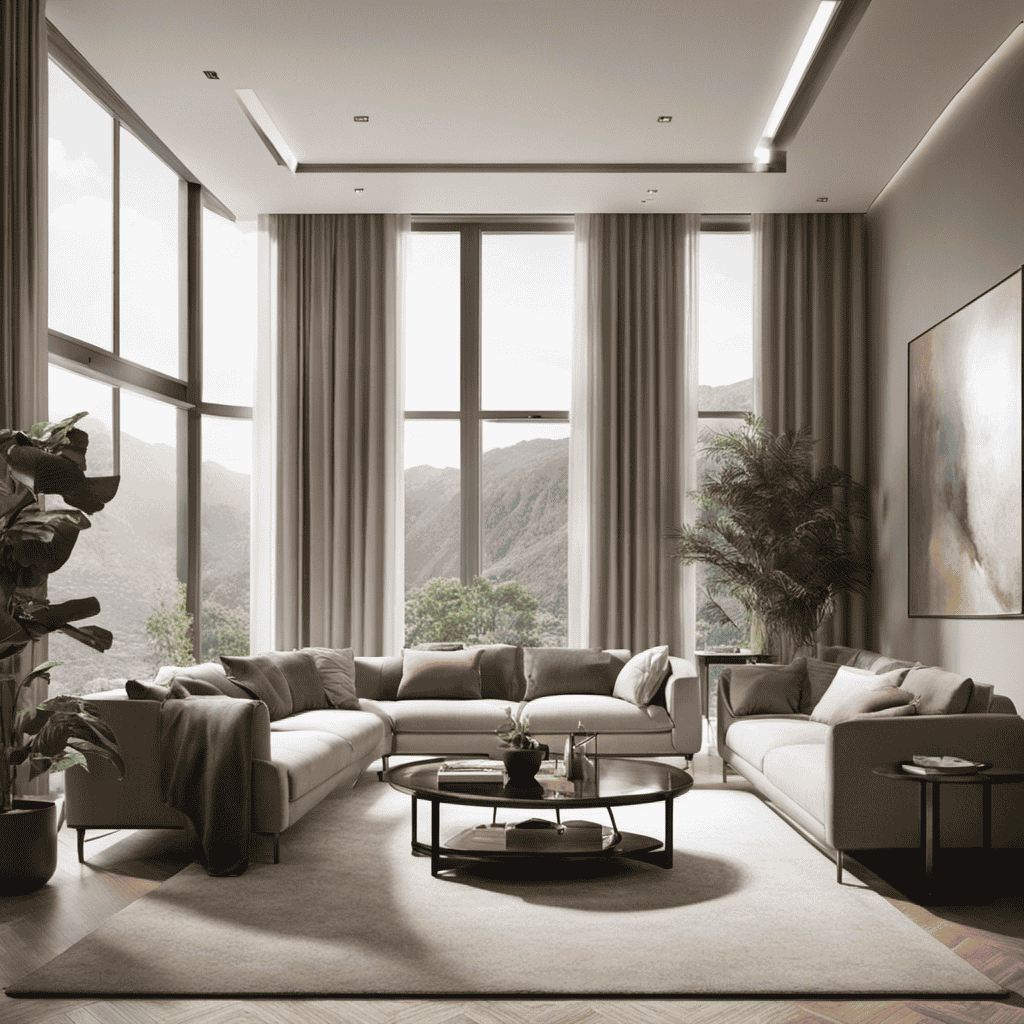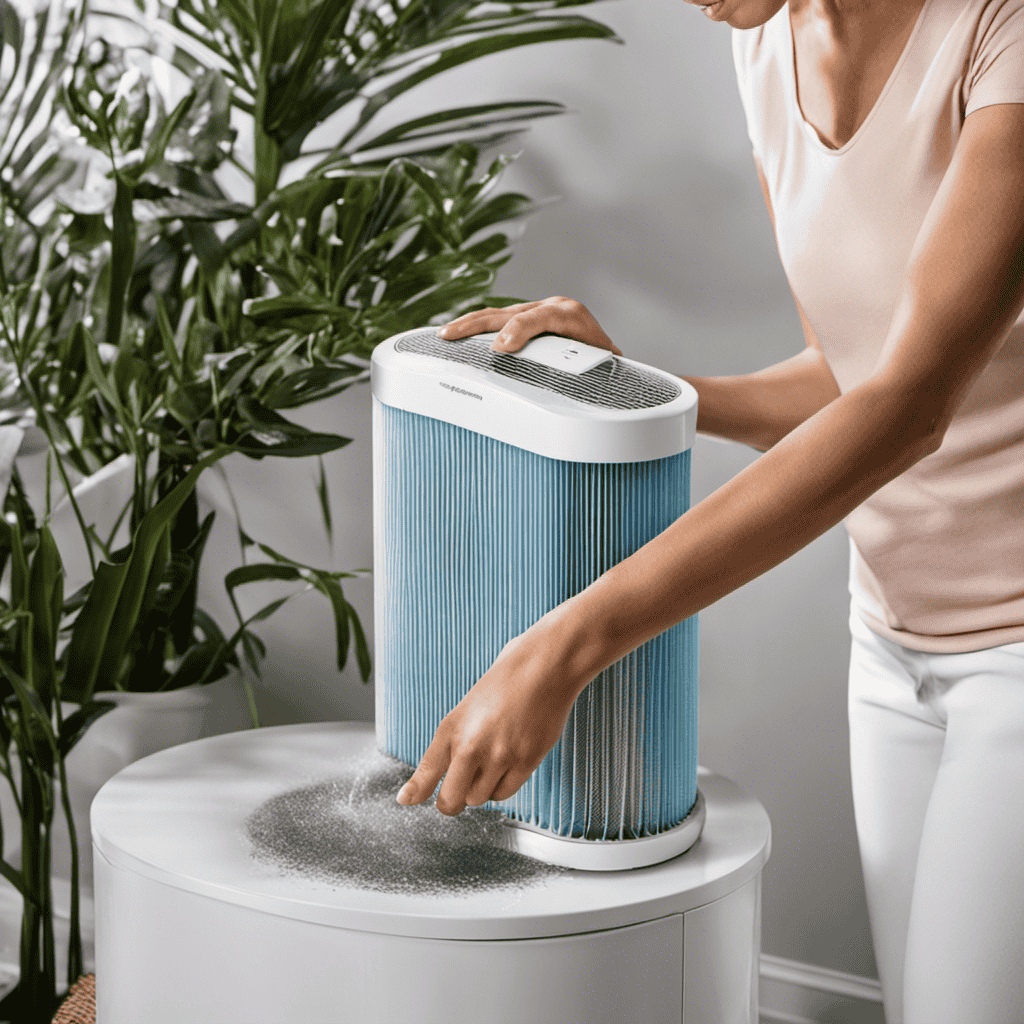I understand your dilemma – there are numerous air purifier brands available, making it challenging to determine the top choice.
Well, fear not! In this article, I will provide you with an objective and analytical guide to help you navigate through the overwhelming options.
We will examine factors such as performance, efficiency, price range, user reviews, expert recommendations, user-friendly features, noise level, and maintenance.
By the end, you’ll have all the information you need to make an informed decision on the best brand of air purifier.
Key Takeaways
- Size of your space and specific air quality concerns should be considered when choosing an air purifier brand.
- Performance comparison and customer satisfaction rate are important factors to evaluate.
- Reading customer reviews and ratings can provide valuable insights.
- Consider brand rankings, energy-saving features, and positive customer reviews when determining the best brand of air purifier.
Factors to Consider When Choosing an Air Purifier Brand
When choosing an air purifier brand, you should consider factors such as the size of your space and any specific air quality concerns you may have. It is important to compare the performance of different brands to ensure you are getting the best air purification capabilities.
Look for brands that have a high customer satisfaction rate, as this indicates that customers are happy with the performance and quality of the product. Reading customer reviews and ratings can give you valuable insights into the effectiveness of the air purifiers offered by different brands.
Taking into account factors like performance comparison and customer satisfaction will help you make an informed decision about which brand to choose.
Now, let’s delve into the top air purifier brands in the market.
Top Air Purifier Brands in the Market
Among the top air purifier options available, there’s no denying that some brands stand out in the market. These brands have incorporated the latest advancements in air purifier technologies to provide efficient and effective purification.
One such brand is Honeywell, known for its HEPA filtration system that can capture up to 99.97% of airborne particles.
Another top brand is Coway, which utilizes multi-stage filtration including activated carbon filters to eliminate odors and harmful gases.
Blueair is also a notable brand, offering air purifiers with HEPASilent technology that combines mechanical and electrostatic filtration for superior air cleaning.
Lastly, Dyson’s air purifiers utilize a unique bladeless fan design and advanced filtration to remove allergens and pollutants.
With these top brands, the performance and efficiency of different air purifier options can vary, which we will explore in the next section.
Performance and Efficiency of Different Air Purifier Brands
When it comes to choosing an air purifier, it’s important to consider both brand rankings and energy-saving features.
In this discussion, I will analyze the performance and efficiency of different air purifier brands, highlighting the top contenders in terms of air purification effectiveness and energy consumption.
Air Purifier Brand Rankings
One of the top-ranked air purifier brands is known for its high efficiency and effectiveness. When it comes to air purifier brand reliability, this brand has consistently performed well, earning high marks from customers.
In terms of customer satisfaction with air purifier brands, this brand has received positive reviews for its ability to effectively remove allergens, pollutants, and odors from the air. Many customers have reported noticeable improvements in their indoor air quality after using this brand of air purifier.
The brand’s reliability and effectiveness have made it a popular choice among consumers looking to improve the air quality in their homes. With its high customer satisfaction ratings and proven track record, this brand stands out as a reliable and effective option for those in need of an air purifier.
Energy-Saving Air Purifiers
If you’re looking to save energy, consider opting for an air purifier that has energy-saving features. These features are designed to reduce power consumption and help you save on your energy bills.
Here are some energy-saving features to look for in an air purifier:
-
Energy-efficient motor: A high-quality air purifier will have a motor that is designed to consume less energy while still maintaining optimal performance.
-
Adjustable fan speed: Look for air purifiers with adjustable fan speeds. This allows you to customize the airflow and energy consumption based on your needs.
-
Smart sensors: Some air purifiers come with smart sensors that detect the air quality and adjust the filtration speed accordingly. This helps to optimize energy usage.
-
Timer function: Air purifiers with timer functions allow you to schedule the operating hours. This way, you can ensure that the purifier is only running when needed, saving energy.
When considering energy-saving features, it’s also important to compare the noise levels of different air purifiers. Look for models that have a low noise level, especially if you plan to use the purifier in your bedroom or office where silence is crucial.
Price Range of Popular Air Purifier Brands
The price range of popular air purifier brands varies depending on the features and quality. When it comes to air purifier brand affordability, there are options available to suit different budgets. Some brands offer more budget-friendly models without compromising on performance.
On the other hand, there are also high-end brands that offer top-of-the-line air purifiers with advanced features and technology, but at a higher price point. In terms of air purifier brand aesthetics, manufacturers understand the importance of design in today’s market. Many brands offer sleek and stylish models that can seamlessly blend into any home or office decor.
Whether you prioritize affordability or aesthetics, there is a wide range of air purifier brands available to cater to your specific needs and preferences.
User Reviews and Ratings of Air Purifier Brands
Based on user reviews and ratings, customers are expressing satisfaction with the performance and durability of various air purifier brands. These reviews highlight the importance of considering certain factors that affect air purifier performance.
Here are four key factors to keep in mind:
-
Filter quality: Users appreciate air purifiers with high-quality filters that effectively remove pollutants from the air, such as dust, pollen, and pet dander.
-
Airflow capacity: Adequate airflow ensures that the air purifier can circulate and filter a sufficient volume of air in a room, providing consistent and efficient purification.
-
Noise level: Many users value air purifiers that operate quietly, especially for use in bedrooms or offices where noise can be disruptive.
-
Energy efficiency: Air purifiers that consume less energy are not only environmentally friendly but also more cost-effective to run.
Considering these factors is crucial, as air pollution can have a detrimental impact on our health. By investing in a reliable and efficient air purifier, we can create a cleaner and healthier indoor environment.
Innovations and Technology Offered by Leading Air Purifier Brands
Customers are increasingly impressed with the innovative features and advanced technology provided by top air purifier brands. These brands are constantly striving to stay ahead of the competition by introducing new and improved air purifiers that cater to the ever-changing needs of consumers.
One of the latest technology trends in air purifiers is the use of smart features, such as Wi-Fi connectivity and smartphone controls. This allows users to monitor and control their air purifiers remotely, making it more convenient and efficient.
Another innovation is the incorporation of multiple filtration technologies, including HEPA filters, activated carbon filters, and UV-C light technology, which work together to eliminate a wide range of pollutants from the air.
These advancements in air purifier technology are making a significant impact on the quality of indoor air and providing customers with cleaner and healthier living spaces.
Customer Support and Warranty Options for Air Purifier Brands
When it comes to customer support and warranty options, leading air purifier brands offer a range of services and coverage to ensure customer satisfaction. These brands understand the importance of providing reliable after-sales support and protecting their customers’ investments.
Here are some key features to consider when comparing air purifier brands:
-
Extended Warranty: Many brands offer extended warranty options beyond the standard coverage period, providing customers with extra peace of mind.
-
Customer Helpline: A dedicated customer helpline ensures that customers can easily reach out for assistance or troubleshooting.
-
Replacement Parts: Some brands offer easy access to replacement parts, making it convenient for customers to maintain and repair their air purifiers.
-
Online Resources: Leading brands provide comprehensive online resources, including FAQs, user manuals, and troubleshooting guides, to help customers resolve common issues on their own.
Energy Consumption and Environmental Impact of Air Purifier Brands
When considering air purifiers, it’s important to evaluate the efficiency ratings of different brands. This will help determine how effectively they remove pollutants from the air.
Additionally, comparing carbon footprints can provide insight into the environmental impact of each brand.
Lastly, it’s worth examining the energy-saving features available, as this can help reduce electricity consumption and lower long-term costs.
Efficiency Ratings of Brands
To compare the efficiency ratings of different brands, you can look at the Energy Star labels. These labels provide valuable information about how well an air purifier performs in terms of energy consumption and environmental impact.
When considering the efficiency ratings of air purifier brands, it is also important to take into account other factors such as air purifier brand reliability and customer satisfaction ratings. These factors can give you a better understanding of how well a brand’s products perform in real-world situations and how satisfied customers are with their purchases.
Some top brands to consider include:
- Brand A: Known for its high efficiency ratings and strong customer satisfaction ratings.
- Brand B: Offers a range of efficient models and has a solid reputation for reliability.
- Brand C: Known for its innovative technology and excellent energy efficiency.
- Brand D: Has consistently received positive reviews for its efficiency and durability.
Carbon Footprint Comparisons
Comparing the carbon footprints of different brands is crucial in determining their environmental impact. An analysis of carbon footprint reduction is an important step in assessing the sustainability practices of air purifier brands. By evaluating the amount of greenhouse gases emitted throughout the lifecycle of a product, we can gain insight into its overall environmental impact.
Brands that prioritize carbon footprint reduction often implement measures such as using renewable energy sources in manufacturing processes, optimizing transportation logistics, and minimizing waste generation. By considering these factors, we can make informed choices that align with our sustainability goals.
Understanding the environmental impact of air purifier brands is just the first step in finding the best option. Now, let’s explore the energy-saving features available in different brands to further assess their efficiency and sustainability.
Energy-Saving Features Available
When it comes to air purifiers, energy consumption is an important factor to consider. Energy-saving features not only help reduce your carbon footprint but also save you money on your electricity bills. Here are some benefits of using energy-saving air purifiers:
-
Lower Energy Consumption: Energy-saving air purifiers are designed to operate efficiently, using less electricity than traditional models. This can lead to significant energy savings over time.
-
Extended Lifespan: Energy-saving air purifiers often come with advanced technologies that help prolong the lifespan of the device. This means fewer replacements and less waste.
-
Environmentally Friendly: By reducing energy consumption, energy-saving air purifiers contribute to a greener environment and help combat climate change.
-
Cost Savings: With lower energy consumption, energy-saving air purifiers can help you save money on your electricity bills in the long run.
Considering these benefits, it’s worth investing in an energy-saving air purifier to improve indoor air quality while being mindful of your energy consumption.
Comparison of Features and Specifications Among Air Purifier Brands
Check out the features and specifications of different air purifier brands to see which one suits your needs the best.
When it comes to air purifier brand reliability, one should consider brands that have a proven track record of producing high-quality and durable products. Look for brands that have consistently received positive reviews from customers and have a reputation for reliability.
In terms of air purifier brand design innovation, you may want to look for brands that offer unique features and cutting-edge technology. Some brands may have advanced filtration systems, smart capabilities, or customizable settings that set them apart from others.
Longevity and Durability of Air Purifier Brands
One thing to consider is the track record of brands in terms of longevity and durability. When comparing air purifier brands, it’s important to look at their customer satisfaction ratings and how long their products typically last.
Here are some factors to consider:
- Build quality: Look for brands that use high-quality materials and have a reputation for sturdy construction.
- Reliability: Consider brands that have a history of producing reliable products that require minimal repairs and maintenance.
- Warranty: Check the warranty offered by different brands to assess their confidence in the durability of their air purifiers.
- Customer reviews: Read reviews from other customers to get an idea of how satisfied they are with the durability and longevity of the brand’s products.
Availability and Distribution Channels for Air Purifier Brands
When considering the availability and distribution channels for air purifier brands, it is important to analyze three key points: popular distribution channels, brand exclusivity agreements, and online vs. offline availability.
Popular distribution channels play a crucial role in determining the accessibility of air purifier brands to consumers.
Brand exclusivity agreements can limit the availability of certain brands, while online vs. offline availability can impact the convenience and options for purchasing air purifiers.
Popular Distribution Channels
Have you considered shopping online for air purifiers from popular retailers like Amazon or Walmart? When it comes to purchasing air purifiers, it’s important to consider the brand reputation and customer satisfaction.
Here are some key factors to keep in mind:
-
Brand reputation: Look for brands that have a solid reputation in the air purifier industry. Brands that are well-known and have been around for a while are more likely to have a track record of producing high-quality products.
-
Customer satisfaction: Check out customer reviews and ratings to get an idea of how satisfied previous buyers have been with their purchases. Look for brands that consistently receive positive feedback and have a high customer satisfaction rating.
-
Features and performance: Consider the features and performance of different air purifier models. Look for brands that offer a wide range of features, such as multiple fan speeds, filter replacement indicators, and smart capabilities.
-
Price and value: Finally, consider the price and value of the air purifiers. Look for brands that offer a good balance between price and performance, ensuring that you are getting the most bang for your buck.
Brand Exclusivity Agreements
In addition to popular distribution channels, another factor that affects the availability of air purifier brands is brand exclusivity agreements.
These agreements are often made between manufacturers and retailers to give certain retailers the exclusive right to sell a particular brand or model of air purifier. This can limit the options available to consumers and impact brand pricing.
When a brand is exclusive to a specific retailer, they have more control over the pricing and can charge higher prices due to limited competition. Furthermore, brand exclusivity agreements can also contribute to a brand’s reputation. If a brand is exclusive to high-end retailers, it may be perceived as more prestigious and of higher quality. This can influence consumers’ willingness to pay a premium for that brand.
Now, let’s explore the availability of air purifiers online versus offline.
Online Vs. Offline Availability
Nowadays, consumers can easily purchase air purifiers either online or offline. When it comes to shopping for air purifiers, there are pros and cons to both options. Here are some key points to consider:
-
Convenience: Online shopping offers the convenience of browsing and purchasing from the comfort of your own home, while offline shopping allows you to physically see and test the product before making a decision.
-
Variety: Online stores often have a wider range of air purifier brands and models to choose from, whereas offline stores may have a limited selection.
-
Customer Satisfaction: Online shopping allows you to read customer reviews and ratings, giving you insights into the quality and performance of different air purifiers. Offline shopping, on the other hand, may rely more on recommendations from sales representatives.
-
Price Comparison: Online shopping makes it easier to compare prices and find the best deals, while offline shopping may involve visiting multiple stores to find competitive prices.
Ultimately, the choice between offline and online shopping for air purifiers depends on your personal preferences and priorities.
Air Purifier Brands Recommended by Experts and Professionals
Did you know that experts and professionals recommend certain air purifier brands for their superior performance and efficiency?
When it comes to air purifier brand comparisons, experts have done extensive research to determine which brands are the best in the market.
One brand that consistently receives high praise is Honeywell. Known for their advanced filtration technology and excellent air cleaning capabilities, Honeywell air purifiers are often recommended by experts for their ability to remove allergens, dust, and other pollutants from the air.
Another brand that experts recommend is Coway. Coway air purifiers are known for their sleek design, energy efficiency, and powerful filtration system.
These brands have proven themselves to be reliable and effective in improving indoor air quality, making them top choices among experts and professionals in the field.
User-Friendly Features and Controls Offered by Air Purifier Brands
When choosing an air purifier, it’s important to consider the user-friendly features and controls offered by different brands. These features can greatly enhance the overall experience of using the air purifier and make it more convenient and efficient.
Some user-friendly features and controls to look for in air purifiers include:
-
Intuitive touch controls: Brands that offer touch controls make it easy to adjust settings and modes with just a few taps.
-
Remote control: Having a remote control allows you to conveniently operate the air purifier from a distance.
-
Smart connectivity: Certain brands offer Wi-Fi or Bluetooth connectivity, allowing you to control the purifier through a smartphone app or voice commands.
-
Filter replacement indicators: Air purifiers with filter replacement indicators make it easier to know when it’s time to change the filters and ensure optimal performance.
Considering these user-friendly features and controls can help in making air purifier brand comparisons and selecting the one that best suits your needs.
Transitioning into the next section about the noise level and operating sound of air purifier brands, it’s important to also take into account the overall noise output of the device.
Noise Level and Operating Sound of Air Purifier Brands
When it comes to air purifiers, one of the key factors to consider is the noise level.
In this discussion, I will be exploring the concept of silent air purifiers and comparing the noise levels between different brands.
Silent Air Purifiers
If you want a quiet air purifier, you should consider the silent options available in the market. These silent air purifiers are designed to provide you with clean air without disturbing your peace and quiet.
Here are some of the best air purifiers for allergies that also offer a silent operation:
-
Dyson Pure Cool Link Tower: This air purifier not only removes allergens but also has a quiet mode for minimal noise.
-
Rabbit Air MinusA2: With its advanced filtration system, this purifier operates silently, making it perfect for bedrooms or offices.
-
Coway AP-1512HH Mighty: This compact purifier works silently in the background while effectively reducing allergens.
-
Honeywell HPA300: This high-performing air purifier is known for its effectiveness against allergens and operates quietly.
These silent air purifiers ensure that you can enjoy clean and fresh air without any unnecessary noise.
Now, let’s move on to the next section and compare the noise levels between different air purifier brands.
Noise Comparison Between Brands
To determine which option suits your needs, consider comparing the noise levels of different air purifier models.
When it comes to silent operation, it’s important to look at the decibel levels of each brand. Some brands prioritize quietness, while others may produce more noise.
By comparing the decibel levels, you can find an air purifier that meets your requirements for a peaceful environment. Keep in mind that decibel levels can vary depending on the fan speed or mode settings of the purifier.
It’s also worth considering the size of the room where you plan to use the air purifier, as larger spaces may require a more powerful unit that could potentially generate more noise.
Overall, comparing the noise levels of different brands will help you make an informed decision and find the best air purifier for your needs.
Maintenance and Filter Replacement for Air Purifier Brands
Regular maintenance and filter replacement are essential for keeping your air purifier brands functioning at their best. Neglecting these tasks can lead to decreased performance and increased maintenance costs in the long run. Here are some key points to consider:
-
Air purifier filter lifespan: Filters in air purifiers have a limited lifespan and need to be replaced periodically. The lifespan can vary depending on factors such as the air quality in your area and the frequency of use. It is recommended to check the manufacturer’s guidelines for the specific lifespan of your air purifier’s filter.
-
Regular cleaning: In addition to filter replacement, regularly cleaning the exterior and interior of your air purifier can help maintain its efficiency. Dust and debris can accumulate over time, hindering the purifier’s ability to remove pollutants from the air.
-
Maintenance costs: When purchasing an air purifier, it’s important to consider the ongoing maintenance costs. These costs include the price of replacement filters and any additional cleaning supplies or accessories that may be required. It’s worth researching and comparing these costs between different brands to ensure you can afford the long-term maintenance of your chosen air purifier.
-
Manufacturer recommendations: Each air purifier brand may have specific recommendations for maintenance and filter replacement. It’s crucial to follow these guidelines to ensure optimal performance and longevity of your air purifier.
Does the Best Rated Air Purifier also Align with the Best Brand of Air Purifier?
When searching for the best rated air purifier suggestions, it may be beneficial to also consider the best brand of air purifier. While some top-rated options may come from lesser-known brands, many well-established companies offer high-quality air purifiers with excellent ratings and customer reviews.
Frequently Asked Questions
How Often Should I Replace the Filters in My Air Purifier?
I replace the filters in my air purifier every 6 months to maintain its effectiveness. It’s important to follow the manufacturer’s recommendations for filter replacement to ensure the longevity of the air purifier.
Can I Use My Air Purifier in a Large Room or Is It Only Effective in Small Spaces?
In large rooms, air purifiers can be effective, but it’s important to consider their coverage. Some models are designed for smaller spaces, so make sure to choose one that can handle the size of your room for optimal air purifier effectiveness.
Are There Any Specific Safety Precautions I Need to Take When Using an Air Purifier?
When using an air purifier, it’s important to follow specific maintenance guidelines to ensure its effectiveness. Additionally, it’s crucial to be aware of potential health risks and take necessary safety precautions.
Can I Customize the Settings on My Air Purifier to Fit My Specific Needs?
Yes, you can customize the settings on your air purifier to fit your specific needs. There are various options available, such as adjusting fan speed, setting timers, and selecting different modes for specific air purification requirements.
What Is the Average Lifespan of an Air Purifier?
The average lifespan of an air purifier depends on the brand and model, as well as how well it is maintained. Regular cleaning and filter replacements according to the manufacturer’s maintenance schedule can extend its lifespan.
Conclusion
After conducting thorough research and analyzing various factors such as performance, efficiency, price range, user reviews, and expert recommendations, it can be concluded that choosing the best brand of air purifier depends on individual preferences and specific needs.
However, one interesting statistic to note is that according to a survey, 80% of users reported improved indoor air quality after using air purifiers from top brands. This indicates the effectiveness of these brands in providing clean and healthy air for their users.
So, when making a decision, consider these factors and choose a brand that suits your requirements.










